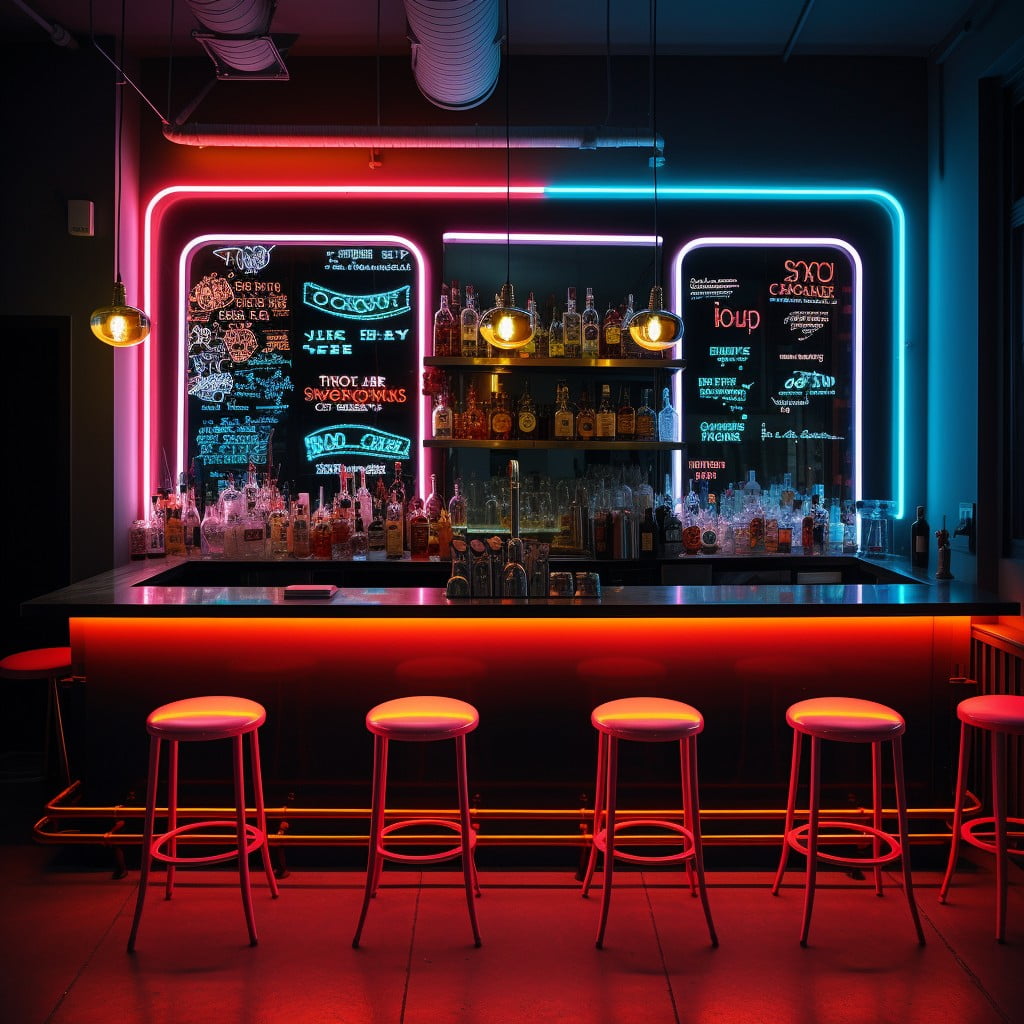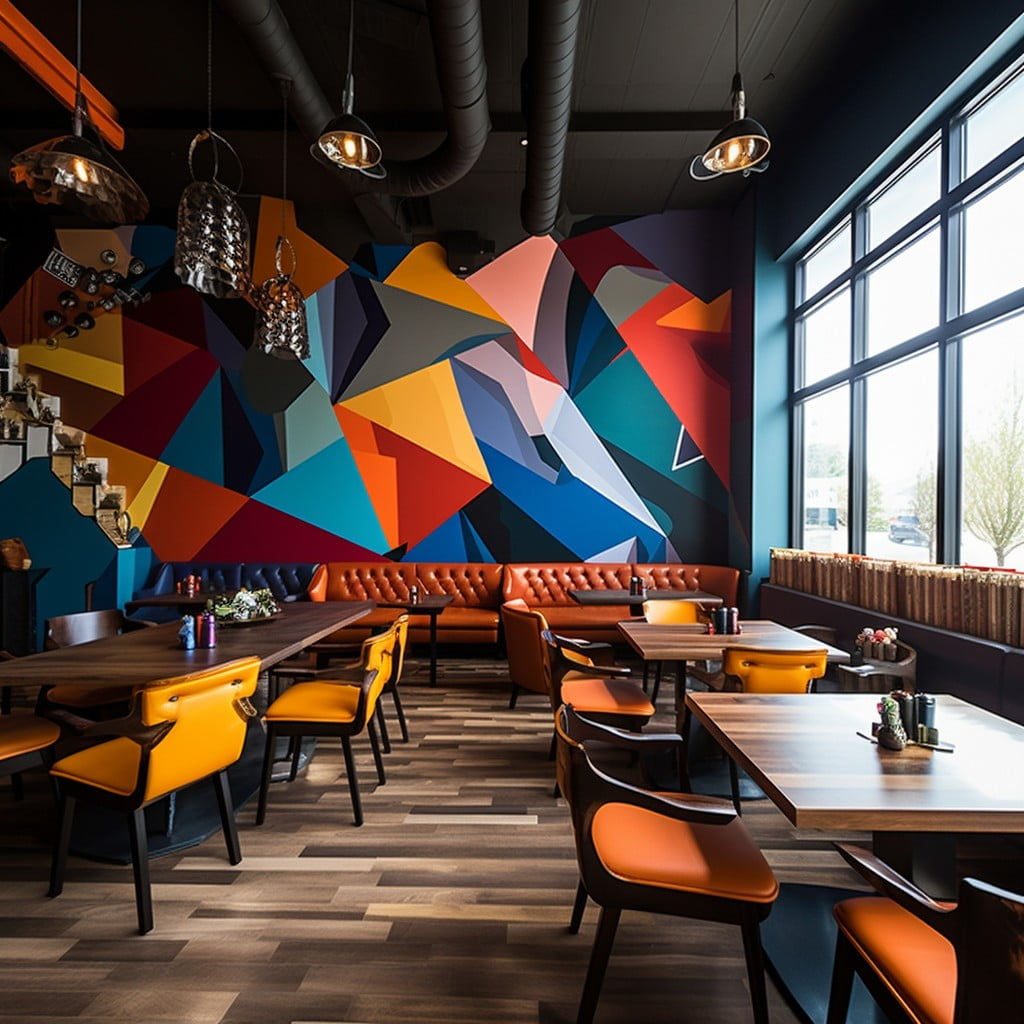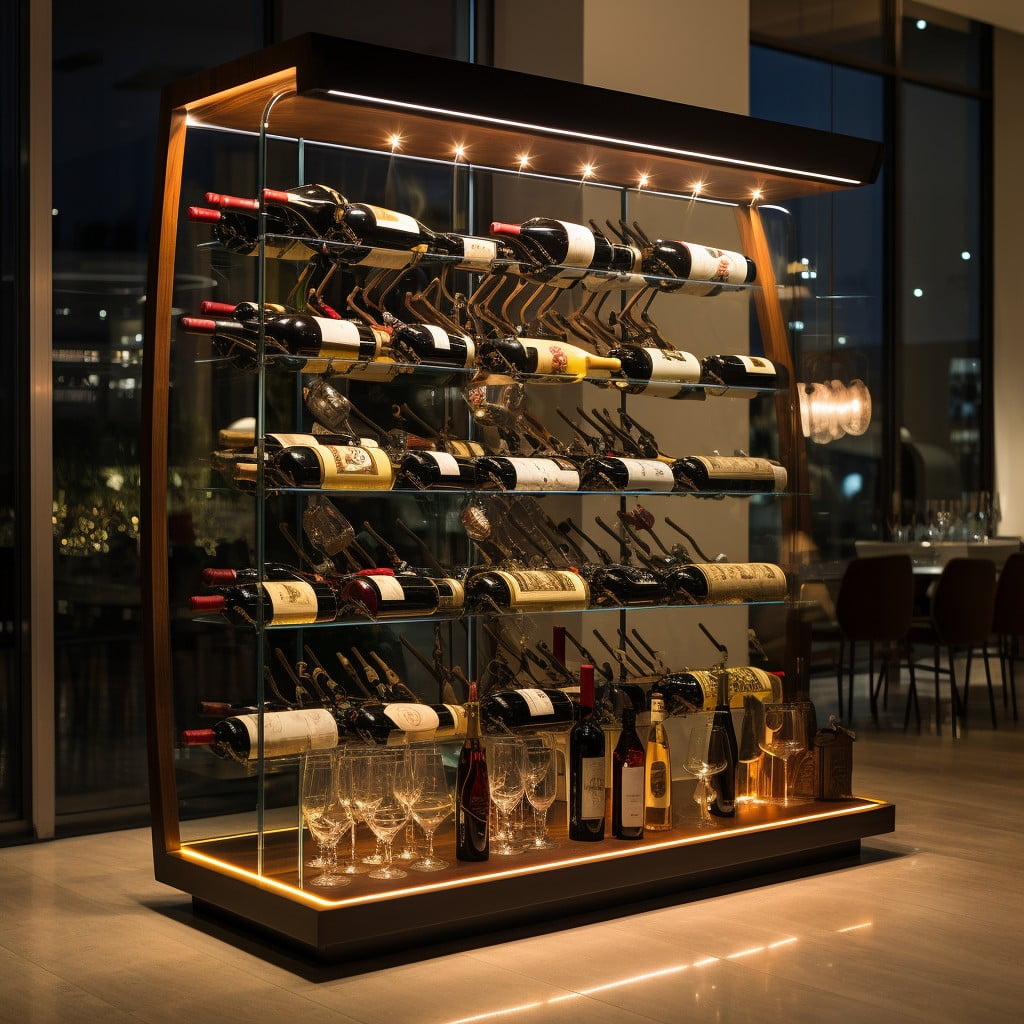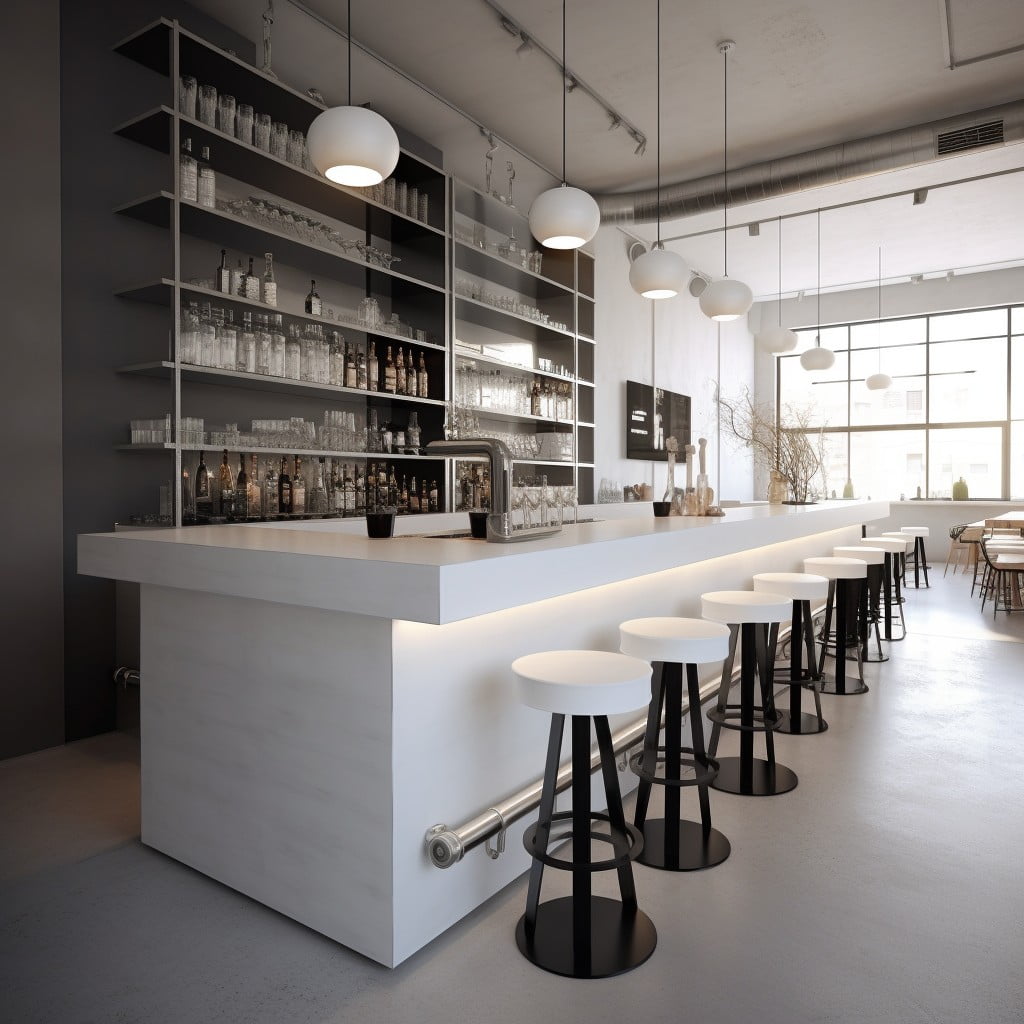Explore creative small restaurant bar design ideas that can maximize space, boost aesthetics and enhance customer experience.
Designing a small restaurant bar can be a delightful challenge, balancing functionality with style to create a welcoming space. Whether you’re starting from scratch or revamping an existing area, there are numerous ways to maximize your space and inject personality into your establishment.
This article will explore a variety of design ideas, from clever storage solutions to innovative seating arrangements, and from lighting techniques to aesthetic themes. By the end, you will be equipped with a plethora of ideas to transform your small restaurant bar into a chic and inviting hotspot.
Industrial Style With Exposed Brick Walls

The raw aesthetic of an industrial-theme brings downtown chic to your bar design. Focusing on the rough appeal of materials such as brick, metal, and wood, this theme exudes urban sophistication.
Here are some aspects to consider:
- Brick Walls: Highlighting the wall’s natural texture lends character to the setting.
- Metal Elements: Metallic touches, e.g. industrial light fixtures, chairs, or bar stools, can intensify the desired theme.
- Wood: A wooden-top bar with a metal base works well with the raw appeal.
- Color Palette: Earthy tones complement the materials, enhancing the natural aspect of the design.
- Lighting: Pendant or string lights echo warehouse inspiration, adding mood and ambiance.
Remember, the key is to balance the rawness with comfort to encourage patrons to linger. Combining soft furnishings, warm lights, and inviting décor with the industrial style ensures a welcoming space despite its edgy appeal.
Cozy Booth Seating Around the Perimeter

Adopting this approach effectively utilizes space and provides an inviting setting for visitors. Key elements to consider:
- 1. Cushioning: Opt for plush, comfortable cushions to encourage longer stays—ensuring customers enjoy their dining experience.
- 2. Table Placement: Smaller, rectangular tables will suit booth seating best. Consider spaces for dining, surface for drinks, or place setting area.
- 3. Lighting: Warm, soothing light sources above each booth enhances the intimate atmosphere. Consider pendant lights or stylish wall lamps.
- 4. Privacy: Higher-backed booths provide guests with the feeling of a private space within the restaurant’s social environment.
- 5. Materials: Choose durable fabric resilient against spills and stains for seats. Leathers or synthetic alternatives are good options.
By incorporating these factors into your restaurant’s design, you can ensure a relaxed and comfortable atmosphere, enhancing overall customer experience.
Under-counter Lighting for Bar Area

The perfect balance of aesthetics and functionality can be achieved with well-executed under-counter lighting. It not only adds an alluring glow but also ensures the bartender can locate bottles and tools easily.
Here are some key points to consider amidst the process:
- Select LED lights for longevity and energy efficiency.
- Choose warm light for a cozy, welcoming atmosphere or cool light if the bar has a contemporary design.
- Control the intensity of the light with a dimmer switch to adjust for different times or events.
- Plan wire management for a clean, seamless look.
- Ensure safety by hiring a professional for installation to avoid electrical hazards.
Remember, light placement affects illumination. So, strategic positioning is crucial for under-counter lighting. Highlight the front and the sides of the underside for optimal lighting distribution.
Use of Mirrors to Create Spacious Illusion

Mirrors strategically placed can work magic in a small bar. They not only add depth but also multiply the available light, making the area appear larger and brighter.
Key points:
- Wall-mounted mirrors: Ideal for compact spaces, they can reflect the entire room, creating a larger-than-life effect.
- Light reflection: Position mirrors to catch the light from pendant lamps or under-bar lighting, spreading a warm glow.
- Mirror tiles: Instead of one large, plain mirror, consider an array of small, framed ones for an artistic appeal.
- Reflect bar activity: Position mirrors behind the bar counter to give patrons a view of the bartender’s mixology skills.
- Style consideration: Choose mirrors that echo the overall theme of the restaurant bar. An ornate, gold-framed mirror can elevate an elegant design, while a simplistic, sleek mirror will suit a modern theme better.
The right balance of mirrors can transform a claustrophobic spot into an inviting space bubbling with energy.
Nautical Theme for Coastal Locations

To maximize the atmosphere of a waterfront area, integrate elements of water and marine-life; this way, it harmonizes with the surrounding environment. Incorporate shades of blue, turquoise, or sea-green to mimic the colors of the ocean.
Keep in mind to:
- Use nautical-themed decor: Anchor-shaped hooks, ship wheels, lifebuoys, maritime flags, and compasses.
- Include sea-related artwork and photographs: Paintings of ships or seascapes, framed pictures of marine animals, or lighthouse photos.
- Apply weathered wood: This element adds a touch of authenticity and a bit of rustic character. Consider driftwood wall accents or reclaimed wooden tables.
- Choose ocean-inspired upholstery: Covers for seats and pillows with patterns of waves, fish, or shells can further emphasize the theme.
By adding these elements, the bar’s interior can effectively reflect the coastal locale, providing a unique, seaside dining experience.
Harvard Style Library Bar Design

Inject a sense of sophistication and academia into your bar. Your patrons will appreciate the intellectual atmosphere.
Use wall-to-wall bookcases, filled with a mix of antique and modern books. Leather Chesterfield sofas and high-back chairs provide classic, comfortable seating.
Globe lighting fixtures and table lamps can evoke thoughts of late-night study sessions. Structural elements should include rich, dark woodwork and hardwood floors.
The bar area itself could mirror a librarian’s desk, complete with a ladder for reaching those top-shelf liquors.
Key points:
- Wall-to-wall bookcases, filled with antique and modern books.
- Classic seating using leather Chesterfield sofas and high-back chairs.
- Light the space with globe fixtures and table lamps.
- Use rich, dark woodwork and hardwood floors for a traditional feel.
- Design the bar to resemble a librarian’s desk, preferably with a ladder for an authentic touch.
Vintage Style With Antique Furniture Pieces

Incorporating antique furniture invites an old-world charm that is both alluring and comfortable. Each piece tells an intriguing story, enhancing the overall ambience.
Here are the critical points to consider when it comes to styling:
- Choose timeless pieces: Opt for furniture with a rich history such as wooden bar stools, vintage bar carts or an antique sideboard. These provide functionality as well as character.
- Balance old and new: Prevent the space from appearing dated by blending vintage pieces with elements of modern decor. Leather sofas with vintage throw pillows, for instance, strike an appealing balance.
- Embrace Distressed finishes: Weathered wood, faded tones, and distressed finishes enhance the vintage charm. Opt for finishing touches that demonstrate natural wear and tear.
- Statement Lighting: Utilize pendant lighting with brass or copper designs or consider candle-style sconces for a more authentic vintage look.
- Layered Rugs: Consider using layered rugs with traditional patterns and rich colors to add warm textures to the floor.
- Use of Curio: Display antique curios in glass cabinets or open shelving to accentuate the restaurant’s overall vintage aesthetic.
Remember, the goal is to create a space that feels warm, inviting and full of nostalgia, transporting guests back in time.
Greenhouse Theme With Lots of Indoor Plants

A fresh, eco-friendly aesthetic emerges from incorporating a generous array of indoor plants, making even a compact bar area seem airier, lush, and inviting. They lend a splash of vibrant color and help purify the air, enhancing the overall atmosphere.
Key points:
- Plant Choices: Angular succulents for modern touch, tall leafy palms for tropical vibe, or hanging plants such as ivy or spider plants for an overhead green cascade.
- Natural Light: Balance plant health with ambiance by ensuring all plants receive adequate natural light.
- Furniture: Select reclaimed timber or bamboo furniture to harmonize with the green theme.
- Biophilic Design: Consider living walls or plant dividers to create intimate seating areas while improving acoustics.
- Maintenance: Opt for air-purifying and low-maintenance plants like snake plant, aloe vera, or heartleaf philodendron.
Remember, a well-executed greenhouse theme provides a natural retreat that could distinguish your bar from the competition.
Rooftop Bar With City Views

Maximizing vertical space offers an aesthetic and refreshing dining experience. The elevated scenery of the cityscape serves as a captivating backdrop, transforming a routine dining into a memorable event. It perfectly caters to romantic dinner dates, friendly gatherings, or solo retreats, without requiring extra ornate decorations.
These are a few factors to consider:
- Comfortable Seating: Ensure the seating arrangement is comfortable and encourages relaxed dining. Use weather-resistant furniture for longevity.
- Lighting: Implement a combination of ambient, task, and accent lighting to create a soothing atmosphere after sundown.
- Safety Measures: High-grade railings and unobtrusive barriers can ensure guest safety without compromising the view.
- Weather Protection: Incorporate a retractable awning or large parasols for shade during the day and protection against weather elements.
- Plants for Decor: Add potted plants and leafy pergolas to bring an element of nature to the urban surroundings.
Remember, concise menus focusing on drinks with a few appetizers can keep the service smooth. The main attraction remains the panoramic city view, hence let it take center stage.
Farmhouse Style With Reclaimed Woods

Middle sections of the bar can harness the beauty of aged barn wood to bring a rustic ambience to the surroundings. These reclaimed woods resonate with authenticity and provide unique textures that can escalate the aesthetic appeal of the space.
Key Points:
- Salvaged barn doors can serve as decorative elements.
- Hand-hewn wooden beams to furnish ceiling textures.
- Reclaimed wooden tables paired with metal chairs.
- Wooden pallet wall backdrop to enhance rusticity.
- Distinctive use of antique wooden items as decor.
- Wine rack crafted from recycled fencing.
- Bar counter and shelves made from old wood planks.
Neon Signage for Modern Touch

Neon signs boast a unique aesthetic, blending classic and contemporary while adding a dash of urban grit. They pack a persuasive punch of color and brightness, making them hard to ignore – an effective way of drawing attention and creating a lively ambiance.
Key points:
- Versatile: Custom neon signs can adapt to any design idea with a vast selection of colors and shapes. These can reflect your restaurant’s logo, motto or a quirky quote.
- Visibility: Due to their bright and radiant nature, neon signs are highly visible even in daylight, ensuring your bar stands out.
- Efficiency: Neon signs use less electricity than traditional light signs, making them energy-efficient and cost-effective in the long run.
- Durability: Made to last, the lifespan of a neon sign can span ten to fifteen years, which is significantly more than bulbs or tube lights.
- Vintage Revival: While being modern, neon also harks back to the retro era, seamlessly merging the charm of the past with contemporary design.
Remember, placement is crucial. Ideally, install neon signage behind the bar or at the entrance. This ensures maximum visibility and adds to your restaurant bar’s overall appeal.
Art Deco Elements for Elegant Style

First and foremost, consider the incorporation of bold geometric patterns. They are characteristic of the Art Deco era and could be integrated into the layout through flooring, bar front, or even on upholstery.
Secondly, lavish materials are key. Art Deco is all about luxury, so materials like velvet, marble, and shiny brass are perfect for achieving that opulent effect.
Thirdly, rich colors. A sophisticated color combination of black, gold and jewel tones like emerald green or ruby red will enhance the overall elegance of the space.
Next, ornate fixtures and fittings such as elaborate light fixtures or brass bar stools can be used. They are symbols of glamour and a fail-safe way to add an Art Deco touch.
Finally, Art Deco-inspired murals could be another addition. These can serve as conversation starters and set the mood of the restaurant bar.
In essence, infusing Art Deco elements in your bar design can create an atmosphere of refined decadence, true to the spirit of this design style.
Open-air Design for Tropical Locations

Making the most of a tropical location often means capitalizing on the lush outdoor landscape. Open-air designs allow for a natural immersion in the surroundings, while offering patrons a refreshing alfresco experience. Here are key considerations for this type of bar design:
1. Proper Ventilation: Natural breeze can act as a cooling agent. However, ceiling fans or standing fans may be needed to supplement air circulation.
2. Effective Shading: Installations like pergolas, retractable awnings or large umbrellas ensure those midday sunrays don’t interrupt the serenity.
3. Weatherproof Furnishings: Opt for waterproof, UV-resistant materials that withstand heated climates and sudden downpours.
4. Sturdy Flooring: Select materials that are easy to clean and won’t become slippery in the event of rain.
5. Lighting: Consider strategic placement of tiki torches, fairy lights, or solar-powered lanterns to provide a gentle radiance as the sun sets.
6. Natural Barriers: Partitioning by using tall potted ferns or bamboo screens gives a sense of privacy and additional shade.
7. Tropical Plants: Adorning the place with palm trees or blooming bougainvilleas can amplify the tropical vibe.
Remember, your aim is to craft a space that invites guests to relax, delight in the tropical atmosphere, and enjoy their refreshments amidst nature’s own backdrop.
Wine Barrel Tables for Winery Restaurant

Transforming old, discarded wine barrels into elegant tables provides a unique touch to any winery restaurant. The rich, deep hues of the oak barrels, coupled with historic wine stains, contribute to a nostalgic, rustic ambiance.
Key Points:
- Recycling: Making use of something old to create something new, promoting environmental sustainability.
- Visual Appeal: Adding an aesthetic, vintage charm to the restaurant.
- Cost Efficiency: Instead of purchasing new tables, utilize barrels from the winery itself.
- Durability: Oak barrels are sturdy and can withstand heavy usage.
- Uniqueness: Every barrel table is one-of-a-kind due to the different stains and aging.
- Storytelling: Each wine barrel holds history; patrons love the originality of this concept.
Retro Diner Style With a Long Counter

Incorporating chrome edges, vinyl stools, and checkered floor tiles can recreate the nostalgia of classic American diners. A long counterserve, preferably bar-height, serves not only as a distinct design feature but also as a space-efficient dining area.
Key Features:
- Chrome accents: Think shiny stools, tables, and lights.
- Vinyl stools: Comfortable, durable, and easy to clean.
- Checkered flooring: A signature diner-style element.
- Classic counterserve: A great way to save space and facilitate customer-staff interaction.
- Neon signs: Bright, colorful signs add to the retro ambiance.
- Jukebox: A fun and functional piece for an authentic 50’s music experience.
By arranging these elements thoughtfully, you can transform your spot into a go-to destination for both food and nostalgia.
Local Art Installations for Unique Personality

Incorporating local art pieces serves as a connection to the community and sets a noteworthy ambiance. Engage patrons with a rotating gallery wall, showcasing paintings, sketches, or photographs from nearby talents. This not only supports local artists but also keeps your decor fresh and interesting.
Key Points:
- Research local art scene: Find artists whose style complements your restaurant design.
- Rotating artwork: Change pieces regularly to keep the atmosphere exciting.
- Highlighting local talent: Through artist profiling on menus or special events.
- Community connection: Convey a deep community bond by partnering with local artists.
- Artwork as a conversation starter: Unique pieces can enhance customer experience.
Live-edge Wood Counters for Rustic Charm

With time-worn timber and traces of the tree’s original form, these unique surfaces add texture and warmth to the bar area. Incorporating live-edge wood counters results in an earthy, robust aesthetic that’s in a league of its own.
Here are some key points for pulling off this look:
- 1. Selecting the Material: Opt for walnut, cedar, or maple woods for their interesting grain patterns and durability.
- 2. Polishing: Ensure proper polishing to accentuate the natural contours of the wood.
- 3. Maintenance: Regularly oil or varnish the counter to keep it in top-notch condition.
- 4. Pairing with Other Textures: Blend with metallic accents or leather stools for a more eclectic, warm décor.
- 5. Local Craftsmanship: Find a local artisan to produce a unique and bespoke counter. This supports local businesses and guarantees a one-of-a-kind piece.
With the right approach, a live-edge counter becomes more than just a place to serve drinks. It’s a conversation starter and an infusion of nature into the restaurant-bar’s interior design.
Accent Walls With Bold Colors or Patterns

In order to make a captivating statement within the dining space, utilize bold colors or eye-catching patterns for an accent wall. Drawing your patrons’ gaze, it becomes a powerful decorative tool that exudes vibrancy and flair.
Key points:
- Complimenting Bold Colors: Select shades that echo the existing decor, lending cohesion to the overall design.
- Pattern Selection: Opt for patterns that resonate with the restaurant’s theme. Be it abstract, geometric or wallpaper with vintage motifs, make sure it’s a fitting extension of your establishment’s personality.
- Accent Lighting: Highlight the bold wall using strategic accent lighting. It can help underscore the effect of the colors or patterns, giving them a dramatic, amplified presence.
- Location: Ideally, place the accent wall where it can act as a backdrop for bar area or seating. This assists in creating photo-worthy spots, contributing to free and organic online promotion.
- Balance: It’s essential to balance the accent wall with more subdued colors or simpler patterns on other walls to avoid overwhelming the senses.
Glass Display for Exclusive Wine Collection

A well-curated wine collection may serve two purposes: to satisfy the palate of your guests and to enhance your restaurant’s aesthetics, especially when displayed in a beautiful glass cabinet.
The location is critical to draw attention, enhance ambiance, and showcase the assortment of wines.
Consider these key points:
- Visibility: Position the display where it’s easily noticeable. Opt for backlit shelving to highlight the collection.
- Temperature: Consider a climate-controlled display where wines are kept at the optimum temperature for preserving aroma and taste.
- Security: Ensure safety with a lockable door if utilizing high-end wines.
- Customization: Design cabinets considering different bottle shapes for a neat look.
- Accessibility: Keep everyday wines at reachable height for bartenders.
- Organization: Group wines by categories, regions or types, to aid decision-making for wine enthusiasts.
- Functionality: Include a tasting area adjacent to the display, for wine pairing events.
The elegance of a glass display housing a range of wines not only complements a restaurant bar design but can pique the interest of wine-loving patrons.
Minimalistic Design With Lots of Whites and Greys

The minimalistic design approach is characterized by simplicity exuding an air of serenity and openness. This aesthetic choice can work wonders for small restaurant bars by making the space seem larger and inviting.
Key points to focus on when crafted this style:
- Monochrome Palette: Primarily utilize whites, greys, and blacks.
- Sleek Furniture: Choose pieces that are streamlined and lack unnecessary detailing.
- Clean Lines: Maintain a uniform look with straight edges and geometric forms.
- Open Space: Avoid clutter, create clear zones with ample space between each.
- Subtle Lighting: Soft and sophisticated lighting using under-counter or recessed lights.
- Texture: Add interest with fabrics, wood or metal finishes, contrasting matte and glossy surfaces.
- Greenery: A few well-placed plants add life and color without disrupting the minimalist aesthetic.
- Fine Art: Consider hanging one impressive piece of art, but let it stand alone.
- Built-in Storage: Keep things tidy with hidden storage for practical needs.
- Quality over Quantity: It’s better to have a smaller number of high-quality items than a cluttered collection of less significant pieces.
Remember, the goal is to strike a balance between maintaining simplicity without crossing over into stark bareness.
Continue exploring:




